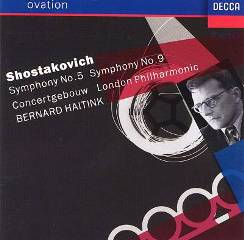Dmitri Shostakovich - Symphony no.5 (Haitink) [1983]
Dmitri Shostakovich - Symphony no.5 (Haitink) [1983]

1.Moderato 2.Allegretto 3.Largo 4.Allegro non troppo Royal Concertgebouw Orchestra Bernard Haitink – conductor
In 1936, the Soviet government launched an official attack against Dmitri Shostakovich's music, calling it "vulgar, formalistic, [and] neurotic." He became an example to other Soviet composers, who rightfully interpreted these events as a broad campaign against musical modernism. This constituted a crisis, both in Shostakovich's career and in Soviet music as a whole; composers had no choice but to write simple, optimistic music that spoke directly (especially through folk idioms and patriotic programs) to the people and glorified the state.
In light of these circumstances, Shostakovich's Fifth Symphony (first performed in 1937) is a bold composition that seems to fly in the face of his critics. Although the musical language is pared down from that of his earlier symphonies, the Fifth eschews any hint of a patriotic program and, instead, dwells on undeniably somber and tragic affects -- wholly unacceptable public emotions at the time. According to the cellist Mstislav Rostropovich, the government would certainly have had Shostakovich executed for writing such a work had the public ovation at the first performance not lasted 40 minutes. The official story, however, is quite different. An unknown commentator dubbed the symphony "the creative reply of a Soviet artist to justified criticism," and to the work was attached an autobiographical program focusing on the composer's metamorphosis from incomprehensible formalist to standard-bearer of the communist party. Publicly, Shostakovich accepted the official interpretation of his work; however, in the controversial collection of his memoirs (Testimony, by Solomon Volkov) he is quoted as saying: "I think it is clear to everyone what happens in the Fifth. The rejoicing is forced, created under threat...you have to be a complete oaf not to hear that."
Regardless of its philosophical underpinnings, Shostakovich's Symphony No. 5 is a masterpiece of the orchestral repertory, poignant and economical in its conception. There is no sign of the excess of ideas so common in the Fourth Symphony. Instead, Shostakovich deploys the orchestra sparingly and allows the entire work to grow naturally out of just a few motives. Given some of his earlier works, the Fifth is conservative in language. Throughout the work he allows the strings to be the dominant orchestral force, making soloistic use of the woodwinds and horn especially effective. The Moderato begins with a jagged, foreboding canon in the strings that forms the motivic basis for the entire movement. The impassioned mood is occasionally interrupted by a lyrical melody with string ostinato, later the subject of a duet for flute and horn.
The second movement (Allegretto) is a grotesque 3/4 dance which, at times, can't help but mock itself; the brass section is featured prominently. The following Largo, a sincere and personal outpouring of musical emotion, is said to have left the audience at the work's premiere in tears. Significantly, it was composed during an intensely creative period following the arrest and execution of one of Shostakovich's teachers.
The concluding Allegro non troppo has been the center of much debate: some critics consider it a poorly constructed concession to political pressure, while others have made note of its possible irony. While the prevailing mood is triumphant, there is some diversion to the somber and foreboding, and it is not until the end that it takes on the overtly "big-finishy" character for which it is so noted. --- Allen Schrott, Rovi
download: uploaded yandex 4shared mediafire solidfiles mega zalivalka filecloudio anonfiles oboom
Zmieniony (Piątek, 09 Maj 2014 11:47)








